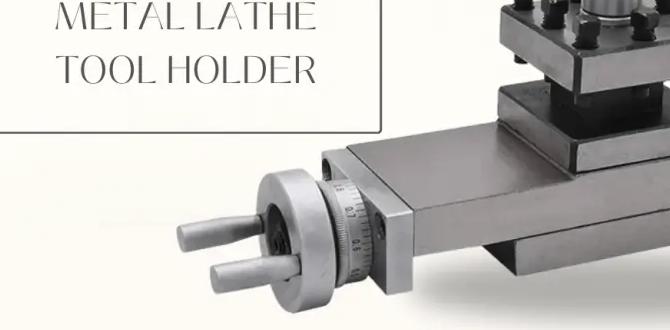Quick Summary:
For clean acrylic cuts, a specialized carbide end mill designed for chip evacuation is essential. These mills feature unique fluting to efficiently remove acrylic chips, preventing melting and ensuring smooth, precise finishes. Choosing the right one means better results and less hassle.
Carbide End Mill: Genius Acrylic Chip Evacuation for a Perfect Cut
Working with acrylic can be a dream, or it can be a sticky, frustrating mess. You know the look: melted plastic clinging to your workpiece, a rough edge that needs hours of sanding, and maybe even some chipped material. It’s a common problem, especially when using the wrong tools. But what if I told you there’s a secret weapon for achieving beautifully clean acrylic cuts every single time? It’s all about mastering acrylic chip evacuation, and the genius behind it is often a specially designed carbide end mill.
Let’s dive into why this matters and how the right end mill can transform your acrylic projects from frustrating to fantastic. We’ll explore what makes these cutters so special and how to pick the perfect one for your needs.
Why Acrylic Chip Evacuation is a Big Deal
Acrylic, or PMMA (polymethyl methacrylate), is a fantastic material for makers, hobbyists, and even professionals. It’s clear, durable, and easier to work with than glass. However, it has a low melting point. When you’re cutting or milling acrylic, friction generates heat. If this heat builds up, the acrylic starts to melt.
When acrylic melts, it causes sticky chips that can:
- Weld themselves back onto the workpiece, creating an uneven and unsightly surface.
- Gunk up the flutes (the spiral grooves) of your end mill.
- Lead to tool breakage due to excessive drag and heat.
- Cause a poor finish, requiring extensive post-processing like sanding and polishing.
Effective chip evacuation is key to preventing this melting scenario. It means getting the melted or softened material away from the cutting edge as quickly as possible, allowing the cutter to work efficiently and the acrylic to stay cool.
Understanding Carbide End Mills for Acrylic
Carbide end mills are made from tungsten carbide, a super-hard material that holds its edge exceptionally well. This makes them ideal for cutting tougher materials and for demanding applications. When it comes to acrylic, however, it’s not just about hardness; it’s about the design of the flutes.
The Importance of Flute Design
For acrylic, you typically want an end mill with fewer flutes and a polished or high-luster finish. Why?
- Fewer Flutes (e.g., 1 or 2): This creates larger chip pockets. Bigger pockets mean more space for chips to collect and be carried away. More flutes would mean smaller pockets, trapping chips and leading to heat buildup.
- Polished or High-Luster Flutes: A smooth, polished surface reduces friction between the acrylic chips and the end mill. This prevents chips from adhering to the cutter and helps them slide out more easily.
This specialized design ensures that as the end mill spins and cuts, it not only removes material but also efficiently ejects the softened acrylic debris.
Common End Mill Types (and why they DON’T work for acrylic)
Let’s quickly touch on why standard end mills, often used for metal or wood, aren’t ideal for acrylic:
- Standard Two-Flute End Mills: While better than those with more flutes, a standard 2-flute mill might not have the polished finish required.
- Multi-Flute End Mills (3, 4, or more): These are designed for faster material removal in metals and harder plastics. Their smaller flute volumes trap chips in acrylic, leading to melting.
- Uncoated End Mills: While some uncoated carbide mills can work, they often don’t have the enhanced chip evacuation features.
This is where the “genius” chip evacuation comes in.
The Genius of Acrylic-Specific Carbide End Mills
Acrylic-specific carbide end mills take the principles of flute design and surface finish to the next level. They are designed with these key features:
- Single or Double Flute Design: As mentioned, this maximizes chip clearance.
- High Helix Angle: A steeper helix angle (the angle of the spiral) helps to quickly lift chips out of the cut and away from the workpiece.
- Polished or Mirror Finish Flutes: Crucial for preventing chip adhesion and reducing friction.
- Sharp Cutting Edges: Clean, sharp edges make for a cleaner cut and less material deformation.
- Special Coatings (Optional but beneficial): While polished flutes are paramount, some specialized coatings can further reduce friction and heat. However, for acrylic, the flute geometry and finish are far more critical than coatings used for high-temperature metal cutting.
One of the most popular and effective types is the single-flute, single-edge, highly polished end mill. This design is optimized for clearing chips and preventing melting. Sometimes you might see these referred to as “plastic cutting” or “acrylic cutting” end mills.
When to Choose Specific End Mills
For the best possible results when cutting acrylic, especially for intricate designs or critical tolerances, investing in an acrylic-specific carbide end mill is highly recommended. If you’re just doing a quick rough cut and don’t mind a bit more cleanup, a general-purpose end mill might suffice, but you’ll likely sacrifice quality and speed.
Choosing the Right Carbide End Mill for Your Acrylic Project
Selecting the correct end mill is a crucial step. Let’s break down what to look for, focusing on common beginner needs, like perhaps a carbide end mill 3/16 inch 8mm shank long reach for acrylic chip evacuation.
Key Specifications to Consider
When browsing for an end mill, you’ll see a series of numbers and terms. Here’s what they mean in the context of acrylic machining:
| Specification | What it Means | Why it Matters for Acrylic |
|---|---|---|
| Diameter | The cutting width of the end mill (e.g., 1/8″, 3/16″, 1/4″). | Determines the smallest detail you can cut and the overall width of your toolpaths. A smaller diameter is good for details, a larger one for faster material removal. |
| Shank Diameter | The diameter of the part that goes into your collet or tool holder (e.g., 1/8″, 3/16″, 1/4″, 8mm, 1/2″). | Must match your machine’s collet system. Common sizes for desktop CNCs and hobby machines are 1/8″, 3/16″, 1/4″, and 8mm. |
| Number of Flutes | The number of helical cutting edges. | For acrylic, aim for 1 if possible, or 2 at most. Single-flute is ideal. |
| Flute Type / Cut Type | Describes the geometry and finish of the flutes. | Look for “single flute,” “plastic cutting,” “acrylic cutting,” “highly polished,” or “mirror finish.” Avoid “unstiffened” or standard end mills. |
| Helix Angle | The angle of the spiral flute. | A high helix angle (e.g., 30-45 degrees) helps lift chips. |
| Length of Cut (LOC) / Effective Cutting Length | How far down the end mill the cutting flutes extend. | A longer LOC allows you to cut deeper in a single pass or create features below the surface. A “long reach” end mill has an extended LOC. |
| Coating | A surface treatment applied to the end mill. | While coatings are common for metal, for acrylic, the polished flute finish is more important. Some specialized plastic coatings exist but are less common than polished flutes. |
Example: The “Carbide End Mill 3/16 Inch 8mm Shank Long Reach for Acrylic Chip Evacuation”
Let’s unpack that specific example:
- Carbide End Mill: It’s made of tungsten carbide for durability.
- 3/16 Inch Diameter: The cutting part is 3/16ths of an inch wide. This is a good general-purpose size for many acrylic projects.
- 8mm Shank: The part that grips into your machine’s collet is 8mm. Note: This means you’ll need an 8mm collet for your spindle. If your machine primarily uses imperial sizes (like 1/4″ or 3/16″), you might need to consider the correct shank size for your setup. Sometimes a 3/16″ shank end mill might be listed with an “8mm equivalent” in informal contexts, but it’s best to always verify your collet sizes. In this specific case, you would need an 8mm collet.
- Long Reach: This implies the end mill has an extended length of cut, allowing it to reach deeper into material or make deeper features.
- For Acrylic Chip Evacuation: This phrase tells you it’s specifically designed for cutting acrylic, focusing on those crucial chip-clearing features (likely fewer flutes and a polished finish).
When looking for this type of tool, always double-check the flute count and finish description to ensure it’s truly optimized for acrylic.
Best Practices for Machining Acrylic with Carbide End Mills
Even with the perfect tool, proper machining techniques are essential for success. Here are some tips to keep your acrylic cuts clean and your tool running smoothly:
-
- Secure Your Workpiece: Acrylic can move if not properly clamped. Use clamps, double-sided tape, or a vacuum table to ensure your material stays put.
- Test Your Speeds and Feeds: This is perhaps the most critical part. Too fast a spindle speed or too slow a feed rate will generate heat and melt the acrylic. Too slow a spindle speed or too fast a feed rate can lead to poor finish or chatter.
- Spindle Speed (RPM): Generally, lower RPMs are better for acrylic to minimize heat. Start around 10,000-18,000 RPM, but experiment.
- Feed Rate (IPM or mm/min): This is how fast the cutter moves through the material. You want a steady feed rate that allows the end mill to cut cleanly and evacuate chips. Start with a conservative feed rate and increase it until you get a consistent, thin chip.
A good rule of thumb is to aim for a chip load that produces thin, dry curls of acrylic, not sawdust or melted goo. You can often find starting point recommendations from the end mill manufacturer or in CNC machining forums.
- Use a High Feed Rate Relative to Spindle Speed: This ensures you’re actually cutting material rather than rubbing.
- Make Multiple Shallow Passes: Instead of trying to cut the entire depth in one go, make several passes. For example, if you need to cut 1/4″ deep, make 3 or 4 passes of 1/16″ each. This reduces the load on the end mill and allows for better chip evacuation at each depth.
- Consider Air Blast or Coolant (Optional): While not always necessary with the right end mill, a gentle stream of compressed air directed at the cutting area can help blow chips away and keep things cool. Some makers use a light mist of water or a specialized plastic cutting fluid, but proceed with caution, as too much liquid can sometimes create its own issues or contaminate the workpiece if not managed properly. For most hobbyists, air is the go-to.
- Maintain the Tool: Keep your end mills clean. After cutting acrylic, clean out any residual plastic. A blast of air or a quick wipe with a solvent (like isopropyl alcohol) can help.
- Zero Your Z Height Correctly: Starting your cut at the exact surface height is important for consistent depth and finish.
Finding Your “Sweet Spot”: Speed and Feed Charts
For precise results, consulting manufacturer data or CNC machining resources is a great idea. Websites like CNCCookbook or specific end mill manufacturer sites offer valuable insights into recommended speeds and feeds for various materials and tooling. While these might seem complex at first, understanding the principles will greatly improve your machining outcomes.
Here’s a simplified idea of setting your parameters:
- Start with a conservative spindle speed (e.g., 10,000 – 15,000 RPM for a typical hobby router/spindle).
- Calculate a chip load based on your end mill diameter and flute count. For a 3/16″ single-flute end mill, a chip load might be around 0.002 – 0.004 inches per tooth.
- Multiply by the number of flutes (1 in this case) and spindle RPM to get your feed rate:Feed Rate (IPM) = Chip Load (per flute) x Number of Flutes x Spindle RPMExample: 0.003″ chip load x 1 flute x 12,000 RPM = 36 IPM
- Adjust based on observation. If you hear a screaming sound or see melting, slow down your feed rate or reduce spindle speed (or both). If you’re getting chatter or a rough surface, you might need to increase feed rate or spindle speed slightly, or take a shallower depth of cut.
It sounds like a lot, but with a bit of practice, you’ll develop an intuition for what sounds and looks right.
Troubleshooting Common Acrylic Machining Issues
Even with the best setup, problems can arise. Here’s how to tackle them:
Issue: Melting and Chip Welding
- Cause: Too much heat, caused by slow feed rates, high spindle speeds, or ineffective chip evacuation.
- Solution:
- Increase feed rate.
- Decrease spindle speed.
- Use shallower depth of cuts.
- Ensure you are using an acrylic-specific end mill with polished flutes.
- Use air blast to clear chips.
Issue: Chipped or Cracked Edges
- Cause: Bit is too dull, feed rate is too fast, material is too thin, or excessive holding force is applied unevenly.
- Solution:
- Use a sharp, new end mill.
- Slow down your feed rate.
- Support the material well, especially near the edges.
- Consider a slower spindle speed for a less aggressive cut.
Issue: Poor Surface Finish
- Cause: Worn tool, incorrect speeds/feeds, or cutting air.
- Solution:
- Ensure your end mill is sharp and clean.
- Fine-tune your speeds and feeds.
- Make sure your Z-axis zero is accurate.
- Take shallower depth of cuts.
Issue: Tool Chatter (Vibration)
- Cause: Loose machine components, incorrect spindle speed, or unbalanced tool.
- Solution:
- Check for any play in your spindle, collet, or machine axes.
- Experiment with spindle speed – sometimes a slightly higher or lower RPM can help.
- Ensure your end mill is properly seated and balanced.
Frequently Asked Questions about Carbide End Mills for Acrylic
Q1: Can I use a regular metal end mill on acrylic?
A: You can, but it’s not ideal. Regular end mills (especially those with many flutes) tend to trap chips, leading to melting and a poor finish. Acrylic-specific end mills with polished flutes and fewer flutes are designed to prevent this.
Q2: How many flutes should my acrylic end mill have?
A: For acrylic, it’s best to use 1 or 2 flutes. Single-flute end mills are often the best choice for maximum chip clearance.
Q3: Do I need to use coolant when cutting acrylic?
A: Usually, no. A specialized “plastic cutting” end mill with polished flutes







